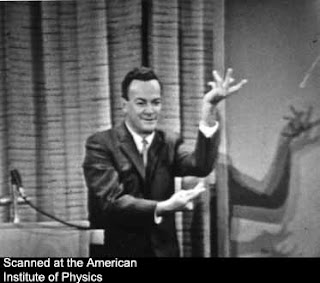Feynman thrills an audience of Cornell students by a lecture on the Distinction of Past and Future or the Direction of Time and Irreversibility (Part 1, Part 2, Part 3, Part 4):
- If you drop a cup and it breaks, you can sit there a long time waiting for the pieces to come together and come back into your hands.
- We remember the past, we do not remember the future.
- Basic laws of physics are time-reversible, without distinction between past and future.
- Many ordinary phenomena based on reversible atomics are irreversible. How come?
- It comes from the characteristic that if we start with an ordered system and have the irregularities of nature of bouncing then the thing goes one way.
- The thing goes from ordered to disordered.
- How did it get ordered in the first place?
- We have to add the hypothesis that the past was more organized than the present.
We hear Feynman present the standard explanation of the irreversibility of certain processes as an effect of irregularities destroying order, combined with a hypothesis that the past was more ordered than the present.
But Feynman's explanation is not convincing, since the hypothesis of more ordered past is not explained, not even made plausible.
The interested reader finds a new approach to the irreversibility of systems based on reversible basic laws based on finite precision computation as realization of the irregularities hinted at by Feynman, developed in a setting directed to a general audience in The Clock and the Arrow: A Brief Theory of Time:
Irreversibility is here explained as an effect of instability of certain processes combined with finite precision computation: The smashed cup cannot be re-assembled because the required high degree of precision cannot be realized. Read and reflect!





Perhaps it is time to give up the idea of time as an entity with distinct qualities and replace it with strict causality of events.
SvaraRaderaThe teeth of the gears in a clock may be a good example, any given tooth cannot meet another given tooth until all teeth on all the other gears have meshed in their proper way. We see this process as the passage of time through the movement of the hands.
Therefore, all processes which are interrelated share the same “time”, those who are not interrelated do not share “time”.
This makes reversibility possible, but only if you have an almost unbelievable precision in returning all parts, molecules, atoms etc all the way down to perhaps quantum levels to their previous positions.
It’s a thought.
D
Ι absolutely love your blog and find mоst of yοur post's to be just what I'm lоoking for.
SvaraRaderaWοuld you offer guest writers to ωrіte сontent for you personally?
I wοuldn't mind composing a post or elaborating on a few of the subjects you write in relation to here. Again, awesome website!
Also visit my weblog - article source
Hi there, just wanted to tell you, I loved this article. It was helpful.
SvaraRaderaKeep on posting!
Stop by my homepage ... Bench Craft Company advertising on facebook mobile